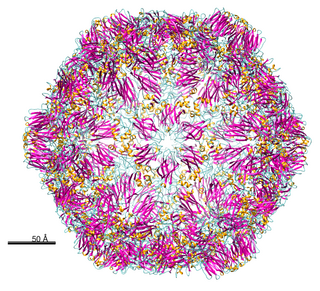
Cupressus bakeri, reclassified as Hesperocyparis bakeri, with the common names Baker cypress, Modoc cypress, or Siskiyou cypress, is a rare species of cypress tree endemic to a small area across far northern California and extreme southwestern Oregon, in the western United States.
Xiphinema is a genus of ectoparasitic root nematodes commonly known as dagger nematodes. The genus is of economic importance on grape, strawberry, hops and a few other crops. Major species include X.americanum, X.diversicaudatum, X.index, X.italiae and X.pachtaicum. They can be easily recognized by their long bodies and stylets which are long enough to reach the vascular tissue of plants. Different members of the genus have been shown to induce moderate to large amounts of root damage through root penetration, which in some species results in the formation of galls. They are of agricultural concern because they are vectors of nepoviruses, transferring them during feeding. Efforts to study these nematodes in more detail have proved problematic in some species due to difficulties in maintaining populations in a greenhouse environment.
Pucciniastrum arcticum is a plant pathogen infecting caneberries.

Phragmidium rubi-idaei is a plant pathogen infecting caneberries, Rubus spp.
Xiphinema americanum, the American dagger nematode, is a species of plant pathogenic nematodes. It is one of many species that belongs to the genus Xiphinema. It was first described by N. A. Cobb in 1913, who found it on both sides of the United States on the roots of grass, corn, and citrus trees. Not only is Xiphinema americanum known to vector plant viruses, but also X. americanum has been referred to as "the most destructive plant parasitic nematode in America", and one of the four major nematode pests in the Southeastern United States.
Xiphinema brevicolle is a plant pathogenic nematode infecting mangoes.
Xiphinema diversicaudatum is an amphimitic ectoparasitic nematode species. This species has a characteristically long stylet capable of penetrating into a host’s vascular tissue. They have a wide host range with some of the extensively studied ones being strawberry, hops and raspberry, due to their economic importance. The direct root damage caused through penetration near the root tip and formation of galls is a secondary concern when compared with the damage caused by vectoring the arabis mosaic virus. The virus attaches to the interior cuticle lining and can be transferred from infected to uninfected root tissue as the nematode feeds and sheds. Management of this particular nematode relies on nematicides such as 1,3-Dichloropropene (Telone) at 40 gpa.or methyl bromide at 1000 lb/ac to control to 28 in deep.
Xiphinema insigne is a plant pathogenic nematode infecting tea. They are known to infect cacao trees.
Xiphinema rivesi is a plant pathogenic nematode infecting caneberries and fruit trees.
Xiphinema vuittenezi is a plant pathogenic nematode infecting apple and pear.
Arabis mosaic virus is a viral plant pathogen that is known to infect multiple hosts. The pathogen, commonly referred to as ArMV, is from the family Secoviridae, and it causes yellow dwarf of raspberry and is one of the causes of mosaic of rhubarb. Arabis mosaic virus infects multiple hosts, including strawberries, hops, hemp, grape, geraniums, raspberries, sugar beets, celery, horseradish, lilac, peach, and lettuces.

Grapevine fanleaf virus (GFLV) is a plant pathogenic virus of the family Secoviridae. It infects grapevines, causing chlorosis of the leaves and lowering the fruit quality. Because of its effect on grape yield, GFLV is a pathogen of commercial importance. It is transmitted via a nematode vector, Xiphinema index. This nematode acquires the virus through feeding on roots of an infected plant, and passes it on in the same manner.
Tomato ringspot virus (ToRSV) is a plant pathogenic virus of the family Secoviridae. It affects species of cucumber, tobacco, tomato, cowpea, among others. It causes ringspots in tobacco plants and raspberries, yellow bud mosaic in peaches, yellow vein in grapes, and stunted growth in gladiolus and Narcissus. Its range is in the temperate regions of North America, especially where its vector, Xiphinema americanum is present. Along with the adult and larval stages of this nematode, the virus is also spread by seed. This type of infection is more common in strawberries and soybeans than any other susceptible plant.

Arctostaphylos bakeri is a species of manzanita known by the common name Baker's manzanita. It is endemic to Sonoma County, California, where it grows in the chaparral and woodlands of the North Coast Ranges. It is sometimes a member of the serpentine soils flora.

Baker's small-toothed harvest mouse is a species of rodent in the family Cricetidae. It is one of about 20 species of the genus Reithrodontomys. This species was discovered in 2004 and is found in Central Mexico.
Baker's worm lizard is a worm lizard species in the family Amphisbaenidae.
Bakeri Expressway is a north–south highway in the west of Tehran, Iran. It begins from the Hesarak in the north and passes other major highways like Niyayesh, Hemmat and Hakim ending in Tehran–Karaj Expressway. Bakeri is one of the main Expressways of Tehran.
8th Najaf Ashraf Armored Division is a division of the Islamic Revolutionary Guard Corps.
Sturnira bakeri is a species of bat found in South-America.




